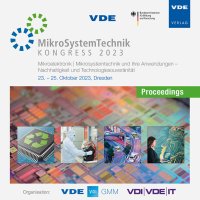Manufacturing of dielectric elastomer transducers using 3D printing
Konferenz: MikroSystemTechnik Kongress 2023 - Kongress
23.10.2023-25.10.2023 in Dresden, Deutschland
Tagungsband: MikroSystemTechnik Kongress 2023
Seiten: 7Sprache: EnglischTyp: PDF
Autoren:
Hubracht, Andreas; Maas, Juergen (Technische Universität Berlin, Mechatronic Systems Lab, Berlin, Germany)
Inhalt:
For the purpose of automatically manufactured dielectric elastomer transducers (DET), an additive manufacturing system with multiple printing technologieswas established. In order to manufacture operating DET, two different kinds of layers must be produced, the electrically conductive electrode and the polymer as dielectric. For applying the electrode, a drop- let-based microdispensing system is used. For the polymer, the direct ink writing (DIW) technology, using a 2-component extruder, was chosen. The latter must produce homogeneous and dimensional layers to avoid electrical breakdown, and thus, allow the operation as actuator. The room temperature curing silicone rubber (Wacker ELASTOSIL(r) RT 625 A/B) in combination with a linear silicone fluid is applied as polymer material.Two DET samples with six and two active layers are produced, mounted as buckling DET (BDET) and tested regarding their mechanical (in-process layer thickness and photos), electrical (capacitance) and electromechanical (static displacement)characteristics. The manufacturing process of the two samples is described in detail. The sample with six active layers shows a mean layer thickness of 63.8 µm and 8.4 µm for the dielectric and the electrode layer, respectively. The maximum transversal displacement of the membrane’s center point was about 300 µm for the sample with two active layers. Results of bothsamples are comparedto a derived static model. Hence, the ability of the 3D printer to manufacturepolymeric-actuators was proven.


